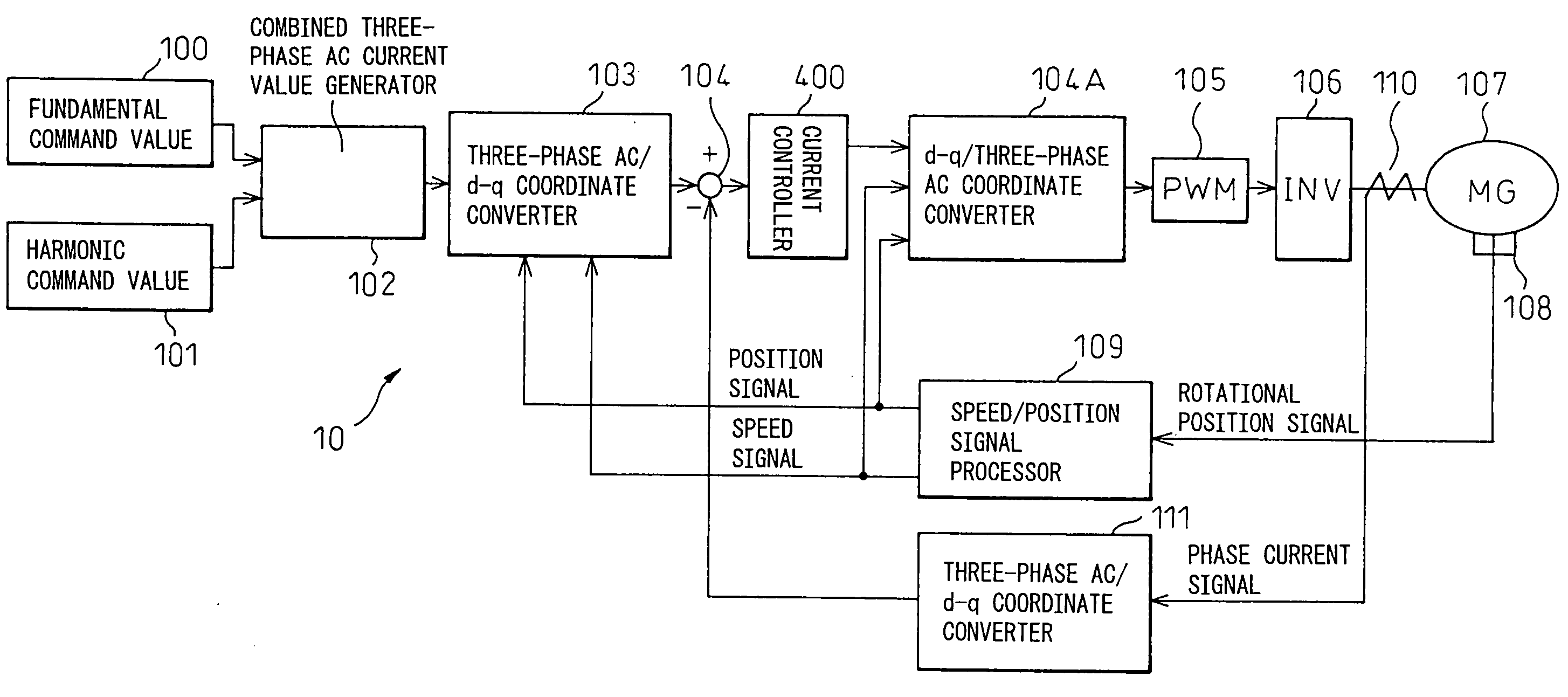Magnetic noise reduction method for AC rotary electric machine, and motor control apparatus and AC rotary electric machine apparatus using the same
- Summary
- Abstract
- Description
- Claims
- Application Information
AI Technical Summary
Benefits of technology
Problems solved by technology
Method used
Image
Examples
configuration example 1
CIRCUIT CONFIGURATION EXAMPLE 1
An example of the circuit for superimposing the above-described harmonic currents is shown in FIG. 3. The motor control circuit shown here is an embodiment that performs the feedback control of the motor current.
Reference numeral 10 is a motor current control means for controlling the motor current of a three-phase synchronous machine 107, and has the following configuration.
Reference numeral 100 is an amplitude / phase commanding circuit block which commands the amplitude and phase of an electric current command value (in three-phase AC coordinate system) corresponding to the fundamental wave. Reference numeral 101 is an amplitude / phase commanding circuit block which commands the amplitude and phase of a harmonic current of a designated order (in three-phase AC coordinate system).
The amplitude / phase commanding circuit block 100 determines the amplitude and phase based on the current command (fundamental wave) received from an external control app...
configuration example 2
CIRCUIT CONFIGURATION EXAMPLE 2
An example of the circuit for superimposing the above-described harmonic currents is shown in FIG. 4.
Reference numeral 100 is an amplitude / phase commanding circuit block which determines amplitude and phase as an electric current command value (in three-phase AC coordinate system) corresponding to the fundamental wave. The command value output from the circuit block 100 is fed to a subtractor 104a via a circuit block 300 which performs conversion from the three-phase AC coordinate system into the d-q axis coordinate system as in the first circuit configuration example. An FFT 111 extracts the detected value of the fundamental component (in three-phase coordinate system) from the phase current output from the current detector. The detected value is first converted by a circuit block 403 from the three-phase AC coordinate system into the d-q axis coordinate system, and then compared in the subtractor 104a with the electric current command value, and t...
configuration example 3
CIRCUIT CONFIGURATION EXAMPLE 3
An example of the circuit for superimposing the above-described harmonic currents is shown in FIG. 5. The circuit shown here employs a filter 113 replacing the FFT 111 shown in FIG. 4, and extracts a fundamental current detection value and a harmonic current detection value.
From the phase current signal detected by the current sensor 110, the detected value of its fundamental component (in three-phase coordinate system) is extracted. The detected value is first converted by the circuit block 403 from the three-phase AC coordinate system into the d-q axis coordinate system, and then compared in the subtractor 104a with the fundamental electric current command value, and their difference is supplied to the coordinate converting circuit block 104B via the gain-adjusting current controller 401. The circuit block 104B outputs a three-phase AC current command value for eliminating the above difference to the adder 112.
A subtractor 117 subtracts the fund...
PUM
 Login to View More
Login to View More Abstract
Description
Claims
Application Information
 Login to View More
Login to View More - R&D
- Intellectual Property
- Life Sciences
- Materials
- Tech Scout
- Unparalleled Data Quality
- Higher Quality Content
- 60% Fewer Hallucinations
Browse by: Latest US Patents, China's latest patents, Technical Efficacy Thesaurus, Application Domain, Technology Topic, Popular Technical Reports.
© 2025 PatSnap. All rights reserved.Legal|Privacy policy|Modern Slavery Act Transparency Statement|Sitemap|About US| Contact US: help@patsnap.com



